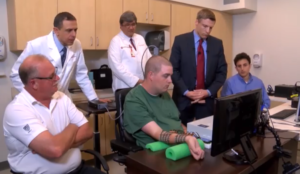
Image: Wexner Medical Center
Twenty-year-old quadriplegic Ian Burkhart recently moved his hand for the first time since he was paralyzed from the neck down in a diving accident several years ago. How was this possible? Physicians and researchers affiliated with the Ohio State Wexner Medical Center and with the Battelle research center have pioneered the “Neurobridge,” a device that transmits signals from a chip implanted in the user’s brain to an electrical sleeve on his arm that in turn activates his muscles.
Chad Bouton, a research leader at Battelle, explains that the device works
much like a heart bypass, but instead of bypassing blood, we’re actually bypassing electrical signals. We’re taking those signals from the brain, going around the injury, and actually going directly to the muscles.
Life will always entail risk, including risk of tragic accidents, but scientists such as these are masterfully mitigating that risk by applying reason and commanding nature. Here’s to the men and women of the mind.
https://www.youtube.com/watch?v=fEbioFpdK5E
Related:
- Review: The Beginnings of Western Science, by David C. Lindberg
- BP Drone Makes Oil Production Safer and More Profitable


![[TEST] The Objective Standard](https://test.theobjectivestandard.com/wp-content/uploads/2017/10/logo.png)









